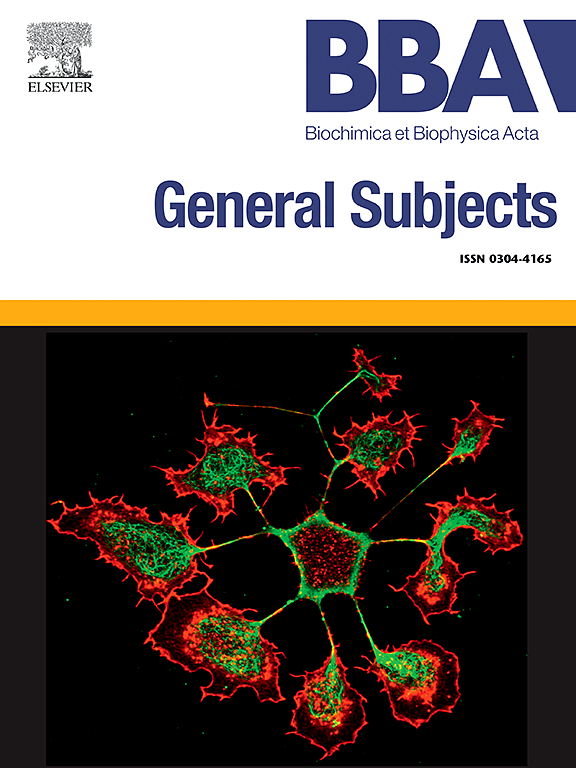Phase separation via protein-protein and protein-RNA networks coordinates ribosome assembly in the nucleolus
IF 2.2
3区 生物学
Q3 BIOCHEMISTRY & MOLECULAR BIOLOGY
Biochimica et biophysica acta. General subjects
Pub Date : 2025-07-16
DOI:10.1016/j.bbagen.2025.130835
引用次数: 0
Abstract
The nucleolus, the largest membraneless organelle in the nucleus, functions as the site for ribosome biogenesis. While long known for its complex and dynamic structure, our mechanistic understanding of nucleolar organization has advanced dramatically in the past 15 years. The process of phase separation (PS) facilitates the compartmentalization of ribosomal components with assembly factors in the nucleolus, underlying complex ribosome biogenesis processes. Multicomponent PS creates multiple nucleolar sub-compartments that function from inside out as a ribosome assembly line. In this review, we discuss the molecular basis of nucleolar organization, including how different types of protein-protein and protein-RNA interactions create the multilayered architecture that enables ribosome biogenesis. Key proteins including nucleolin, fibrillarin, and nucleophosmin mediate nucleolar compartmentalization through their unique structural features and multivalent interactions. The processes of ribosomal RNA (rRNA) transcription, modification and splicing, and folding are spatially and temporally segregated within different regions of the nucleolus. rRNA matures and changes form along this processing continuum, continually altering its interactions with proteins, creating multiple separate liquid phases that establish sub-compartments. We highlight how both folded domains and intrinsically disordered regions (IDRs) in nucleolar proteins contribute to multivalent interactions underlying PS and nucleolar compartmentalization. We also discuss how perturbation of nucleolar PS alters nucleolar structure, dynamics, and function and contributes to a range of pathological conditions.

相分离通过蛋白质-蛋白质和蛋白质- rna网络协调核糖体在核仁中的组装
核仁是细胞核中最大的无膜细胞器,是核糖体生物发生的场所。虽然核仁的复杂和动态结构早已为人所知,但在过去的15年中,我们对核仁组织的机制理解有了显着的进展。相分离(PS)过程促进了核糖体成分与核核中组装因子的区隔化,是复杂的核糖体生物发生过程的基础。多组分PS产生多个核仁亚室,从内到外作为核糖体装配线发挥作用。在这篇综述中,我们讨论了核仁组织的分子基础,包括不同类型的蛋白质-蛋白质和蛋白质- rna相互作用如何创建使核糖体生物发生的多层结构。核仁蛋白、纤维蛋白和核磷蛋白等关键蛋白通过其独特的结构特征和多价相互作用介导核仁区隔化。核糖体RNA (rRNA)的转录、修饰、剪接和折叠过程在空间和时间上分离于核仁的不同区域。rRNA沿着这一加工连续体成熟并改变形态,不断改变其与蛋白质的相互作用,形成多个独立的液相,建立子区室。我们强调了核仁蛋白中的折叠结构域和内在无序区域(IDRs)如何促进PS和核仁区隔化背后的多价相互作用。我们还讨论了核仁PS的扰动如何改变核仁结构,动力学和功能,并有助于一系列病理条件。
本文章由计算机程序翻译,如有差异,请以英文原文为准。
求助全文
约1分钟内获得全文
求助全文
来源期刊

Biochimica et biophysica acta. General subjects
生物-生化与分子生物学
CiteScore
6.40
自引率
0.00%
发文量
139
审稿时长
30 days
期刊介绍:
BBA General Subjects accepts for submission either original, hypothesis-driven studies or reviews covering subjects in biochemistry and biophysics that are considered to have general interest for a wide audience. Manuscripts with interdisciplinary approaches are especially encouraged.
 求助内容:
求助内容: 应助结果提醒方式:
应助结果提醒方式:


